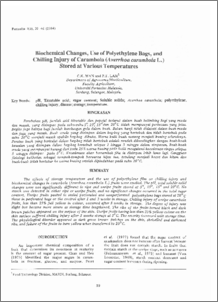Citation
Wan, C.K and Lam, P. F.
(1984)
Biochemical Changes, Use of Polyethylene Bags, and
Chilling Injury of Carambola (Averrhoa carambola L.)
Stored at Various Temperatures.
Pertanika, 7 (3).
pp. 39-46.
Abstract
The effects of storage temperature and the use of polyethylene film on chilling injury and
biochemical changes in carambola (Averrhoa carambola L.) fruits were studied. The pH, total soluble solid
changes were not significantly different in ripe and unripe fruits stored at 5°, 10°, 15° and 20°C. No
starch was detected in either ripe or unripe fruits, and no significant changes occurred in the total sugar
content. Unripe fruits pacted in sealed perforated and nonperforated polyethylene bags stored at 20° C
those in perforated bags or the control after 1 and 3 weeks in storage. Chilling injury of unripe carambola
fruits, less than 25% full yellow in colour, occurred after 5 weeks in storage. The degree of injury was
slight but became more severe as storage time lengthened. The ribs of the fruits turned black and dark
brown patches appeared on the surface of the skin. Unripe fruits having less than 25% yellow colour on the
skin surface suffered chilling injury after 5 weeks storage at 5° C. The severity increased with storage time.
The physiological disorder appeared as dark green brown patches on the skin, shrivelled and darkened
ribs, and failure of the fruits to turn yellow when transferred to 20° C.
INTRODUCTION
An important chemical composition of a
fruit that determines its sweetness at maturity
is the amount of sugar present. Chan and Heu
(1975) identified the major sugars in carambola
as fructose, glucose, and sucrose. Pratt
lFood Technology Division, MARDI, Serdang, Selangor.
39
et al. (1977) found
Download File
![[img]](http://psasir.upm.edu.my/style/images/fileicons/application_pdf.png)  Preview |
|
PDF
Biochemical_Changes,_Use_of_Polyethylene_Bags,_and.pdf
Download (4MB)
|
|
Additional Metadata
Actions (login required)
 |
View Item |

